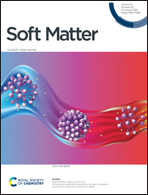Range and strength of mechanical interactions of force dipoles in elastic fiber networks†
Abstract
Mechanical forces generated by myosin II molecular motors drive diverse cellular processes, most notably shape change, division and locomotion. These forces may be transmitted over long range through the cytoskeletal medium – a disordered, viscoelastic network of biopolymers. The resulting cell size scale force chains can in principle mediate mechanical interactions between distant actomyosin units, leading to self-organized structural order in the cell cytoskeleton. Inspired by such force transmission through elastic structures in the cytoskeleton, we consider a percolated fiber lattice network, where fibers are represented as linear elastic elements that can both bend and stretch, and the contractile activity of myosin motors is represented by force dipoles. Then, by using a variety of metrics, we show how two such contractile force dipoles interact with each other through their mutual mechanical deformations of the elastic fiber network. As a prelude to two-dipole interactions, we quantify how forces propagate through the network from a single anisotropic force dipole by analyzing clusters of nodes connected by highly strained bonds, as well as through the decay rate of strain energy with distance from a force dipole. We show that predominant fiber bending screens out force propagation, resulting in reduced and strongly network configuration-dependent dipole interactions. On the other hand, stretching-dominated networks support longer-ranged inter-dipole interactions that recapitulate the predictions of linear elasticity theory. By characterizing the differences between tensile and compressive force propagation in the fiber network, we show how inter-dipole interaction depends on the dipoles’ mutual separation and orientation. The resulting elastic interaction energy may mediate a force between multiple distant dipoles, leading to their self-organization into ordered configurations. This provides a potential pathway for active mechanical force-driven structural order in elastic biopolymer networks.



 Please wait while we load your content...
Please wait while we load your content...